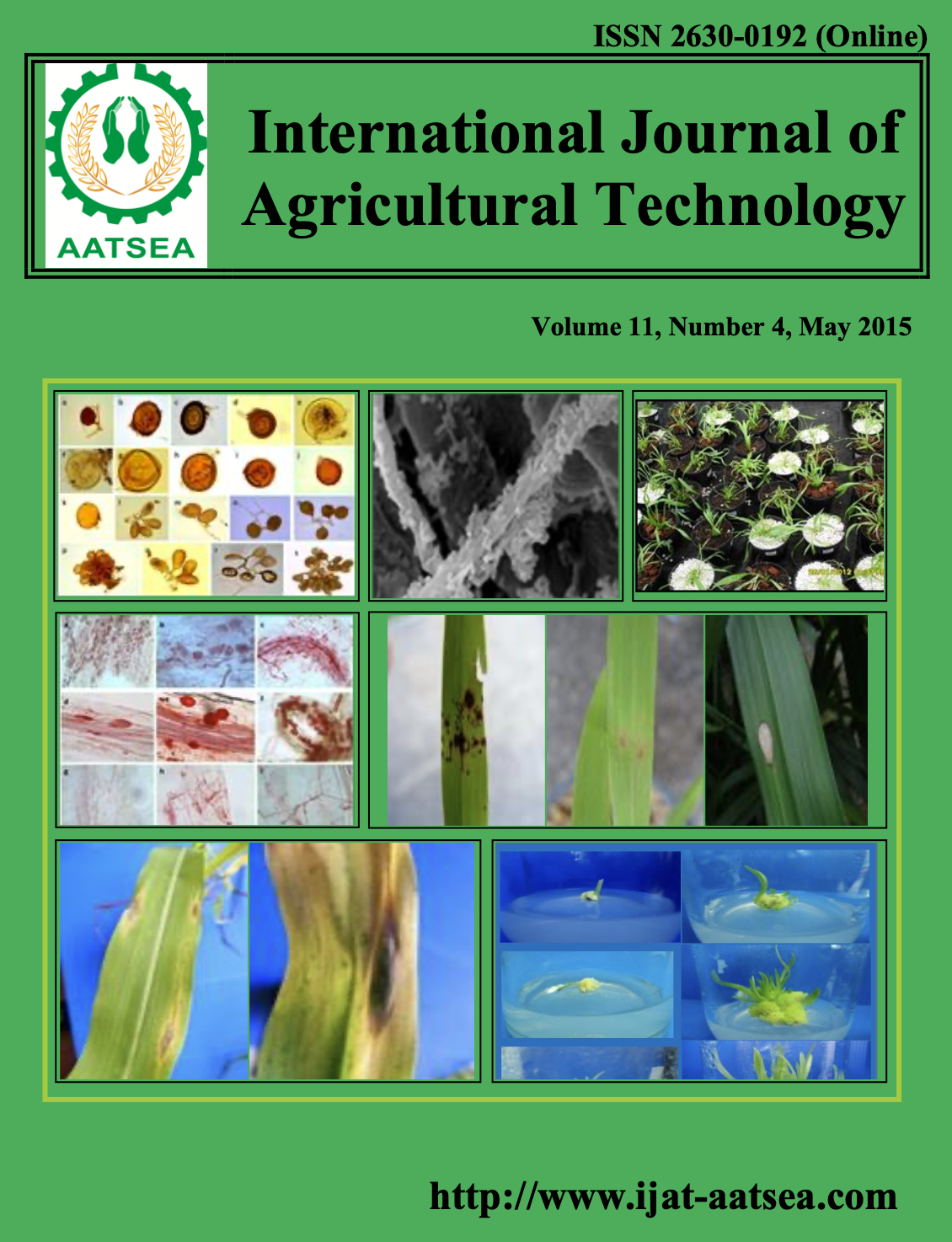Control of the banana Anthracnose Pathogen using Antagonistic Microorganisms
Main Article Content
Abstract
This study aimed to determine the biological control abilities of selected antagonistic microorganisms to inhibit the growth of Colletotrichum musae, the causal agent of anthracnose disease found in banana fruits. In previous studies, Pantoea agglomerans and Enterobacter sp. showed effectiveness in controlling the anthracnose disease. It was found that the maximal germination rate of C. musae was 93.35 % at 31 °C after 35 h. The inhibition of the conidial germination of C. musae by P. agglomerans and Enterobacter sp. occurred 1 h after incubation at 31 °C. At 50 % mixture of P. agglomerans or Enterobacter sp. with PDA showed effectiveness in inhibiting conidial germination by 97.23% and 88.05%, respectively, and the capability to inhibit the mycelial growth of the fungus by 99.61 % and 99.23 %, respectively. The study of direct parasitism showed evidence of antagonist cells around the fungal hyphae, but it did not show that the hyphae became irregular in shape or twisted. Based on the in vivo study, a selected Enterobacter sp. antagonist applied on a banana every week before harvest showed the most effectiveness in controlling anthracnose, with 87.6 % inhibition.
Article Details

This work is licensed under a Creative Commons Attribution-NonCommercial-NoDerivatives 4.0 International License.
References
Ara, I., Rizwana, H., Al-Othman, M. R. and Bakir, M. A. (2012). Sudies of actinomycetes for biological control of Colletotrichum musae pathogen during post harvest anthracnose of banana. African Journal of Microbiology Research 6:3879-3886.
Bazie, S., Ayalew, A. and Woldetsadik, K. (2014a). Antifungal activity of some plant extracts against (Colletotrichum musae) the cause of postharvest banana anthracnose. Journal of Plant Pathology and Microbiology 5:226.
Bazie. S., Ayalew, A. and Woldetsadik, K. (2014b). Effect of hot-water treatments in vitro on conidial germination and mycelial growth of Colletotrichum musae isolates. Journal of Yeast and Fungal Research 5:58-62.
Denner, F. D. N., Kotzé, J. M. and Putterill, J. F. (1986). The effect of temperature on spore germination, growth and appressorium formation of Colletotrichum gloeosporioides and Dothiorella aromatica. South African Avocado Growers’ Association Yearbook 9:19-22.
Droby, S. (2006). Improving quality and safety of fresh fruit and vegetables after harvest by the use of biocontrol agents and natural materials. Acta Horticulture 709:45-51.
El-Ghaouth, A., Wilson, C. L. and Wisniewski, M. E. (2004). Biologically based alternatives to synthetic fungicides for the postharvest diseases of fruit and vegetables. In Naqvi, S. A. M. H. (Ed.), Diseases of Fruit and Vegetables. The Netherlands: Academic Publishers. pp. 511-535.
Haron, F. F., Sijam, K., Omar, D. and Rahmani, M. (2013). Chemical composition and screening for antifungal activity of Allamanda spp. (Apocynaceae) crude extracts against Colletotrichum gloeosporioides, causal agent of anthracnose in papaya. Australian Journal of Basic and Applied Sciences 7:88-96.
Hashem, M. and Alamri, S. (2009). The biocontrol of postharvest disease (Botryodiplodia theobromae) of guava (Psidium guajava L.) by the application of yeast strains. Postharvest Biology and Technology 53:123-130.
Ippolito, A. and Nigro, F. (2000). Impact of preharvest application of biological control agents on postharvest diseases to control wound-invading postharvest pathogens of fruit. Crop Protection 19:715-723.
Janisiewicz, W. J., Tworkoski, T. J. and Sharer, C. (2000). Characterizing the mechanism of biological control of postharvest diseases on fruit with a simple method to study competition for nutrients. Phytopathogen 90:1196-1200.
Jantaporn, T. (2004). Isolation and identification of thermotolerent yeast based on nucleotide. Proceeding of The fifth Princess Chulabhorn International Science Congress, 16-18 August 2004.
Korten, L. (2006). Advanced in control of postharvest diseases in tropical fresh produce. International Journal of Postharvest Technology and Innovation 1:48-61.
Khleekorn, S. and Wongrueng S. (2014). Evaluation of antagonistic bacteria inhibitory to Colletotrichum musae on banana. Journal of Agricultural Technology 10:383-390.
Maqbool, M., Ali, A., Ramachandran, S., Smith, D. R. and Alderson, P. G. (2010a). Control of postharvest anthracnose of banana using a new edible composite coating. Crop Protection. 29:1136-1141.
Maqbool, M., Ali, A. and Alderson, P. G. (2010b). Effect of cinnamon oil on incidence of anthracnose disease and postharvest quality of bananas during storage. International Journal of Agriculture and Biology 12:516-520.
Shi-Ping, T., Guo-Zheng, Q., Yong, X. and You-Sheng, W. (2004). Application of antagonistic yeasts under field conditions and their biocontrol ability against postharvest diseases of sweet cherry. Acta Botanica Sinica 46:1324-1330.
Sutton, B. C. (1980). The genus Glomerella and Its Anamorph Colletotrichum. In Bailey, J. A. and Jeger, M. J. (Eds.), Colletotrichum: Biology, Pathology and Control, Wallingford, UK: CAB international. pp. 1-26.
Teixido, N., Usall, J. and Vinas, I. (1999). Efficacy of preharvest and postharvest Candida sake biocontrol treatment to prevent blue mold on apples during cold storage. International Journal of Food Microbiology 50:203-210.
Wisniewski, M. E. and Wilson, C. L (1992). Biological control of postharvest diseases of fruit and vegetables: Recent advances. HortScience 27:94-98-3.
Zhulong, C. and Shiping, T. (2005). Interaction of antagonistic yeasts against postharvest pathogens of apple fruit and possible mode of action. Postharvest Biological and Technology 36:215-223-6.


